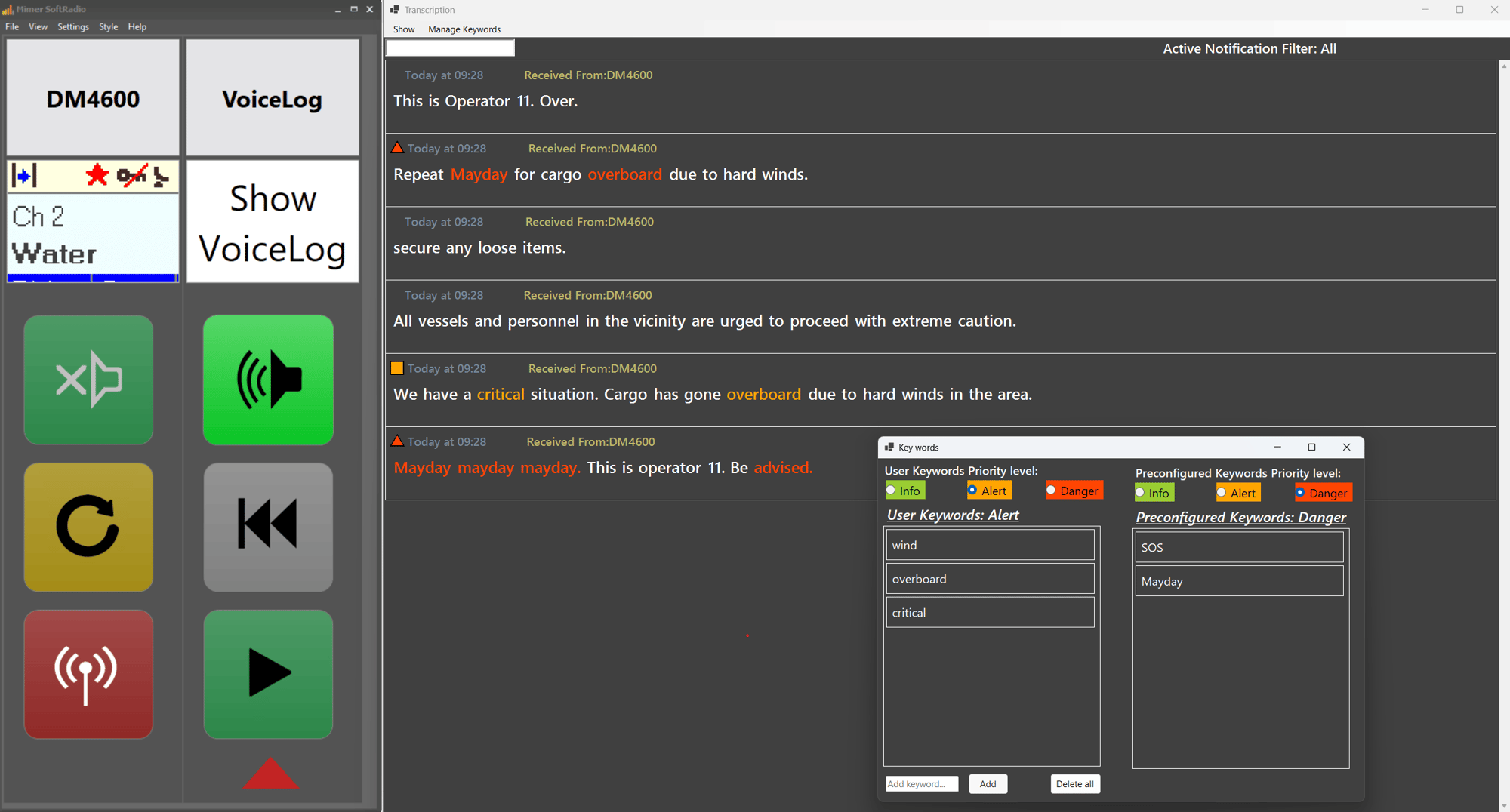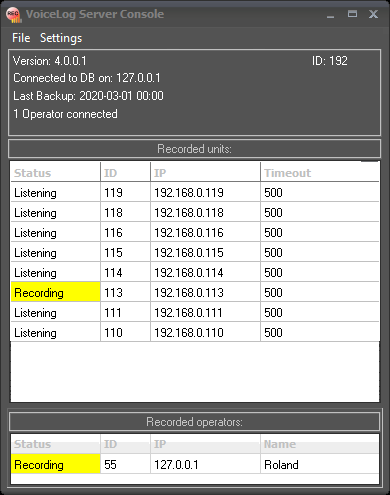Mimer VoiceLog
Mimer VoiceLog will record all audio in your system.
Efficient Recording of Radio and Integrated Devices
Recordings are securely stored on a server, with distinct timestamps for each radio device and dispatcher, ensuring efficient event tracking by administrators.
Additionally, other devices integrated with the SoftRadio system, such as phones and intercoms, are also recorded.
New VoiceLog Feature Launch
As showcased at the Autonomous Ship Expo in June, we are introducing an innovative feature for the VoiceLog. This function will convert radio voice messages into text, allowing operators to both listen to and read recorded messages in plain text.
This feature leverages AI technology to provide accurate transcription. We have also received requests for translation capabilities, and we are exploring this potential enhancement.

Check Out This Video to See VoiceLog AI in Action!
Key Features For AI Transcription
.png?width=70&height=70&name=transcription%20(1).png)
Real-Time Transcription
Automatically transcribes calls in real time, ensuring accurate and searchable records.
.png?width=70&height=70&name=transcription%20(2).png)
Keyword Highlighting
Key terms and phrases are automatically detected and emphasized for quick reference.
.png?width=70&height=70&name=transcription%20(3).png)
Smart Categorization
Calls are intelligently sorted and labeled based on context, improving workflow efficiency.
.png?width=70&height=70&name=transcription%20(4).png)
Alert Integration
Transcribed data can trigger alerts based on predefined keywords or emergency phrases.
.png?width=70&height=70&name=transcription%20(5).png)
Enhanced User Interface
Clear and structured transcription view with easy navigation and playback options.
System Requirements & Performance Benchmark
To ensure optimal performance for AI-based transcription, the following system specifications are recommended:
| Component | Specification |
|---|---|
| CPU | AMD Ryzen 7 5700X or equivalent (Intel Core i7 or higher / AMD Ryzen 7 or higher) |
| RAM | Minimum 16 GB |
| GPU | NVIDIA RTX 4070 or equivalent (NVIDIA RTX 30-series or higher recommended) |
| Operating System | Windows 11 (64-bit) |
Performance & QA Testing
Benchmark Testing Results
| Metric | Result |
|---|---|
| Average Process Time | ≈5 seconds |
| Average Inference Time | 2.26 seconds per transcription |
| Maximum Wait Time | ~33.98 seconds under extreme high loads |
| Stress Test Conditions | 9,000 audio clips of varying lengths with simultaneous radio conversations |
| Outcome | Stable performance even under peak system load |
Accuracy & Quality Assurance (QA)
| Aspect | Details |
|---|---|
| Transcription Accuracy | Validated against 100+ test data points |
| Contextual Understanding | Tested on both short and long audio clips |
| AI Model Initialization Time | Optimized for rapid startup |
The VoiceLog
The VoiceLog server is designed to record and store all audio within your SoftRadio system. Each recording is time-stamped and associated with the ID of the radio or operator, enabling efficient tracking and follow-up.
In digital systems where radios transmit their ID numbers, the ID and talk group of the recorded radio are also captured.
Mimer VoiceLog is available in two configurations:
-
Mimer VoiceLog (Standard) – Ideal for large dispatch centers
-
Mimer VoiceLog LE – Tailored for smaller dispatch centers
Please refer to the table below for detailed specifications.
RTP Gateway: For users who wish to export audio to an external recording system, an RTP gateway is available. Additional details can be found at the bottom of this page.
The image on the left showcases SoftRadio with three radios and a VoiceLog as one device.

VoiceLog at the Dispatcher
Each radio dispatcher is equipped with the ability to review previous conversations, a useful feature when a message is difficult to hear. Instead of requesting the driver to repeat the message, the dispatcher can simply backtrack using the VoiceLog.
In the dispatcher’s replay window, two timelines are displayed for each device in the system: one for outgoing audio and one for incoming audio. Each instance of audio activity is marked with a "bubble" on the timeline, allowing the dispatcher to easily select a bubble and play back the recording.
For digital systems where radios transmit their ID numbers, both the ID and talk group of the recorded radio will be displayed when a bubble is selected.
Dispatchers can also backtrack their own transmissions and, depending on system settings, those of their colleagues. The default backtracking period is 24 hours, though this can be adjusted to accommodate longer or shorter periods.
Please note, in the SoftRadio client, VoiceLog replaces one of the available devices (e.g., radio or phone) from the standard SoftRadio client’s maximum of eight devices (or up to 30 devices with SoftRadio XL).
Additionally, it’s possible to configure the system so that the dispatcher does not have access to the VoiceLog window and cannot listen to recordings, though their transmissions will still be recorded on the server.
The image on the right showcases VoiceLog server console window showing many connected radios and one connected operator.


Mimer VoiceLog dispatcher replay window with three radios and one phone connected. Showing the ID and the talk group of the recorded radio on the first line.


VoiceLog at the Server
All recordings are in standard Wav-format and named with date, time and audio path. 1GB of memory will hold about 20 hours of constant recording. With other words, a modern hard drive will not fill up for several months under normal radio traffic. Depending on hard drive size and traffic load, recordings can be saved for example one year back in time. After that, the information, if needed, can be stored on CD/DVD/external drive through ordinary Windows programs and routines.
The server application has a console window informing of connected radios and connected operators. It will also give basic information on connection to the data base and backup.
From the Settings menu the file were you set up radios to record is reached. All operators that connect will automatically be recorded.
Mimer VoiceLog is Windows software and runs as a Windows Service on most Windows computers or Servers.
VoiceLog Player at the Administrator
To make it easier for an administrator to play back the recorded audio files there is a small utility called VoiceLog Player. (Included in VoiceLog deliveries from mid June 2018)
With the software you can select audio files from the server and easily sort them by date and time as well as dispatcher and radio.
The player has its own setup utility where you can give each radio and dispatcher a name instead of the technical ID numbers that the recordings have.
External use: If for example someone external needs to follow up an event, audio files from that day can be copied from the server to a CD/DVD/USB and be sent over together with the VoiceLog Player, making it easy for anyone to go through the event.
Specification of the two VoiceLog sizes
| Function | VoiceLog | VoiceLog LE |
|---|---|---|
| Number of radios connected to the VoiceLog | 100 | 4 |
| Number of operators connected to the VoiceLog | >200 | 4 |
| Logging of ISSI/GSSI in Tetra systems | Yes | No |
| Logging of individual number/group number in DMR | Yes | No |
| Radios connected in local LAN | Yes | Yes |
| Radios connected remote | Via NetworkRepeater | Via NetworkRepeater |
| Dispatchers connected in local LAN | Yes | Yes |
| Dispatchers connected remote | Yes | Yes |
| Server installation on dispatcher PC | Not recommended | Yes |
| Installation on separate server | Yes | Yes |
Mimer RTP Gateway
In some cases customers prefer to use their own recording systems. For that purpose we have built the RTP Gateway as an alternative to the full Mimer VoiceLog.
The RTP Gateway will sample all audio in the Mimer SoftRadio system, transform it to an RTP audio stream, and route it to a specified IP address. Each devices/radios/operators audio will be sent to a predefined port.
Third party recording systems can then handle the RTP audio stream.
The RTP Gateway is delivered as Windows software and runs as a service. It will autostart and run in the background.

Example of the Console Window of the RTP Gateway

.png?width=70&height=70&name=transcription%20(6).png)